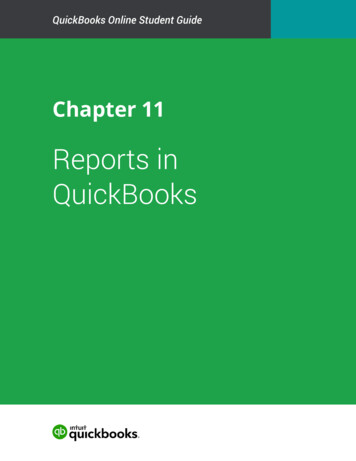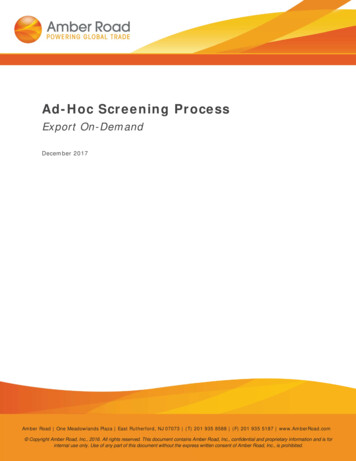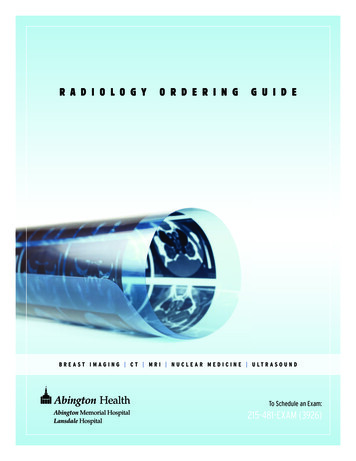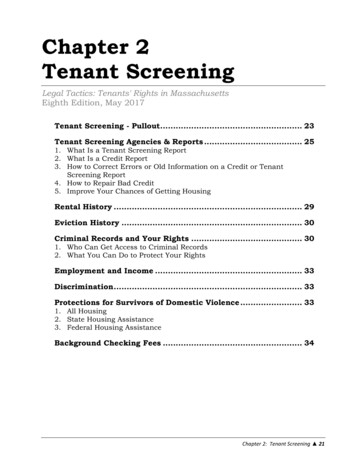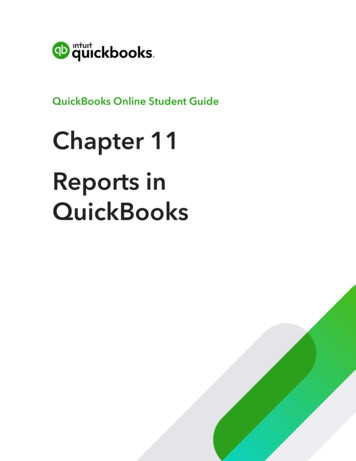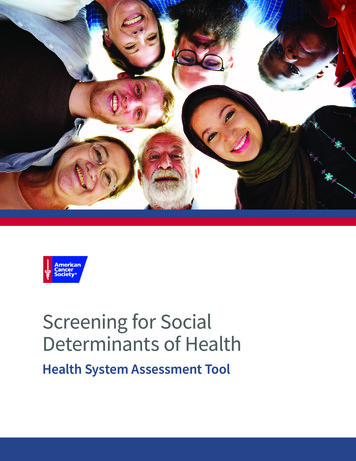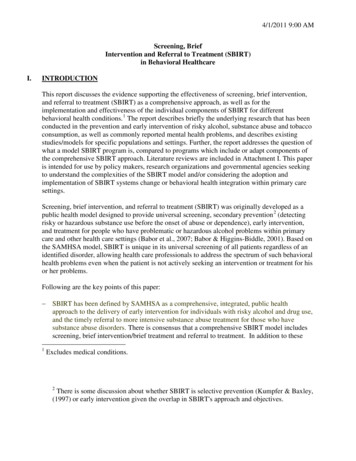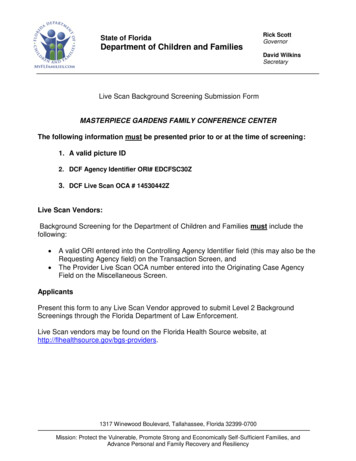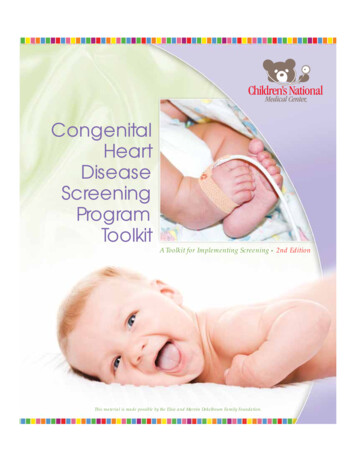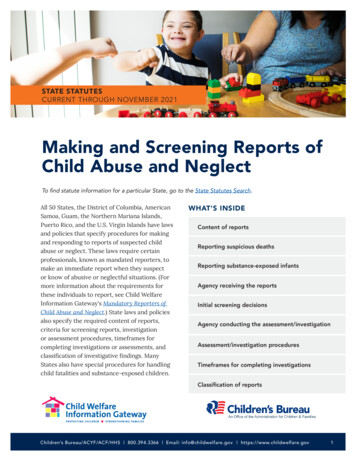
Transcription
STATE STATUTESCURRENT THROUGH NOVEMBER 2021Making and Screening Reports ofChild Abuse and NeglectTo find statute information for a particular State, go to the State Statutes Search.All 50 States, the District of Columbia, AmericanSamoa, Guam, the Northern Mariana Islands,Puerto Rico, and the U.S. Virgin Islands have lawsand policies that specify procedures for makingand responding to reports of suspected childabuse or neglect. These laws require certainprofessionals, known as mandated reporters, tomake an immediate report when they suspector know of abusive or neglectful situations. (Formore information about the requirements forthese individuals to report, see Child WelfareInformation Gateway's Mandatory Reporters ofChild Abuse and Neglect.) State laws and policiesalso specify the required content of reports,criteria for screening reports, investigationor assessment procedures, timeframes forcompleting investigations or assessments, andclassification of investigative findings. ManyStates also have special procedures for handlingchild fatalities and substance-exposed children.WHAT'S INSIDEContent of reportsReporting suspicious deathsReporting substance-exposed infantsAgency receiving the reportsInitial screening decisionsAgency conducting the assessment/investigationAssessment/investigation proceduresTimeframes for completing investigationsClassification of Bureau/ACYF/ACF/HHS 800.394.3366 800.394.3366 Email: Email:info@childwelfare.govinfo@childwelfare.gov https://www.childwelfare.gov https://www.childwelfare.gov1
CONTENT OF REPORTSReports can be made by phone to child protectiveservices (CPS) or a local law enforcement agency.Most States have a statewide child abuse hotlinefor this purpose, and many States have electronicreporting systems for receiving reports on theinternet. In 18 States, American Samoa, Guam,and Puerto Rico, a mandated reporter isrequired to submit a written report after he orshe has made an oral report.1 In nine States,the District of Columbia, and the Virgin Islands,a written report is required only when requestedby the department or agency that received theinitial report.2Most States specify in statute the types ofinformation that should be included in a reportof suspected abuse or neglect. The reporter willbe asked to provide as much information aboutthe child’s situation as he or she can, includingthe names and addresses of the child and thechild’s parents or other persons responsible forthe child’s care, the child’s age, conditions in thechild’s home environment, the nature and extentof the child’s injuries, and information about otherchildren in the home.REPORTING SUSPICIOUS DEATHSApproximately 35 States, American Samoa, Guam,the Northern Mariana Islands, and Puerto Ricoprovide for specific reporting procedures to befollowed when the reporter suspects that childabuse or neglect may have caused the death of achild.3 Typically, the statutes instruct a mandatoryreporter to report a suspicious child death toa medical examiner or coroner. For States thatdo not have specific reporting procedures forsuspicious child deaths, standard child abusereporting procedures apply.REPORTING SUBSTANCE-EXPOSEDINFANTSMothers who use drugs or alcohol during theirpregnancy may give birth to infants who showsigns or symptoms of drug exposure. The FederalChild Abuse Prevention and Treatment Actrequires States to have policies and proceduresto address the needs of substance-exposedinfants.4 Approximately 40 States and the Districtof Columbia have specific notification proceduresfor cases of newborn infants who are diagnosedas suffering from the effects of prenatal substanceexposure of a fetal alcohol spectrum disorder.5In most cases, a notification is not considered areport of child abuse or neglect unless the childis subject to another condition or circumstancethat meets the legal definition of abuse or neglect.Instead of an investigation, the departmentand/or health-care provider must develop aplan of safe care for the infant and the infant’scaregivers.6 In many States, prenatal exposure tocontrolled substances is included in definitions ofchild abuse or neglect.7Alabama, California, Colorado, Connecticut, Hawaii, Illinois, Iowa, Louisiana, Maryland, Massachusetts, Michigan, Minnesota,Mississippi, Nebraska, Nevada, New York, Pennsylvania, and Rhode Island2Georgia, Kansas, Kentucky, Maine, New Hampshire, North Dakota, Ohio, Washington, and West Virginia3The word “approximately” is used to stress the fact that States frequently amend their laws. This information is current throughNovember 2022. The 35 States that provide procedures for reporting suspicious child deaths are Arkansas, California, Colorado,Connecticut, Delaware, Florida, Illinois, Indiana, Kansas, Kentucky, Louisiana, Maine, Massachusetts, Michigan, Minnesota,Mississippi, Missouri, Montana, Nevada, New York, North Carolina, Ohio, Oregon, Pennsylvania, Rhode Island, South Carolina,South Dakota, Tennessee, Texas, Utah, Virginia, Washington, West Virginia, Wisconsin, and Wyoming.442 U.S.C. 5106a(b)(2)(B)(iii) (2019)5Alaska, Arizona, Arkansas, California, Connecticut, Delaware, Florida, Georgia, Illinois, Indiana, Iowa, Kansas, Kentucky, Louisiana,Maine, Maryland, Massachusetts, Michigan, Minnesota, Mississippi, Missouri, Montana, Nebraska, Nevada, New Hampshire, NewJersey, New Mexico, North Dakota, Ohio, Oklahoma, Oregon, Pennsylvania, Rhode Island, South Dakota, Tennessee, Utah, Virginia,Washington, West Virginia, and Wisconsin6For more information on this requirement, see Child Welfare Information Gateway’s Plans of Safe Care for Infants With PrenatalSubstance Exposure and Their Families.7For more information, see Child Welfare Information Gateway’s Parental Drug Use as Child Abuse.1Children’s Bureau/ACYF/ACF/HHS 800.394.3366 Email: info@childwelfare.gov https://www.childwelfare.gov2
AGENCY RECEIVING THE REPORTSIn all jurisdictions, the initial report may be madeto either CPS or a law enforcement agency.Laws in 33 States, the District of Columbia,Guam, and Puerto Rico require State agenciesto maintain centralized telephone lines 24 hoursa day, 7 days a week, for the acceptance of childmaltreatment reports.8 In practice, most Stateshave statewide, toll-free numbers for acceptingreports of maltreatment. In 12 States, statutesallow mandatory reporters to submit reportselectronically via the Internet.9In nine States, a State agency is required to notifya child's Tribe when it is determined that the childis a Native American child or is eligible for Tribalmembership.10 In three States, a report involvingan Indian child residing on Tribal lands can bemade directly to a Tribal authority or be referredto the Tribe for investigation by the State agency.11In three States, the State agency may assist inan investigation only when the Tribe requestsassistance.12 For Indian children not residing onTribal lands, protective agencies in four Statesmay respond to a report, but the child's Tribemust be notified that a report has been received.13In 13 States, the appropriate military authorities,such as representatives of family advocacyprograms, must be notified when a report isreceived that concerns a child whose parentor guardian is a member of the armed forces.14In these cases, CPS and military authoritiesmay share information and coordinate theirinvestigations of the reports.INITIAL SCREENING DECISIONSThe laws and policies in all jurisdictions specifyprocedures for the initial response required bythe agencies receiving the reports. The ultimatepurpose of the reporting system is to ensure thechild's safety and well-being.15 In most States,the agency that receives a report of suspectedchild abuse or neglect will first screen the reportto determine whether it meets the criteria foracceptance. For acceptance, the report mustconcern actions that meet the statutory definitionof child abuse or neglect in that State.16 Typically,this will involve situations of harm or threatenedharm to a child committed by a parent, guardian,or other person responsible for the child's care.Reports that do not meet the statutory criteriaare screened out. Reports that meet the criteriaare screened in and referred to the State CPSagency for response.The approaches used to screen reports vary fromState to State, but nearly all States utilize a typeof safety assessment to determine which reportsrequire immediate responses.17 Approximately 37States and the District of Columbia categorizereports based on the level of risk of harm toArizona, Arkansas, Colorado, Connecticut, Delaware, Florida, Idaho, Illinois, Indiana, Kentucky, Maine, Maryland, Massachusetts,Minnesota, Mississippi, Missouri, Montana, Nebraska, Nevada, New Jersey, New Mexico, New York, Ohio, Oklahoma, Pennsylvania,Rhode Island, South Dakota, Tennessee, Texas, Virginia, Washington, West Virginia, and Wyoming9Arizona, California, Connecticut, Florida, Georgia, Illinois, Maine, Michigan, Mississippi, Nevada, New York, and Pennsylvaniahave provisions for electronic reporting. For a State-by-State listing of telephone numbers and websites for making reports, seeInformation Gateway's State Child Abuse and Neglect Reporting Numbers.10California, Idaho, Maine, Michigan, Minnesota, New Mexico, Oregon, Tennessee, and Wisconsin11Arizona, Minnesota, and New Mexico12Idaho, New Mexico, and Oregon13California, Idaho, Minnesota, and New Mexico14Colorado, Georgia, Idaho, Indiana, Louisiana, New Jersey, Oklahoma, Oregon, South Carolina, South Dakota, Washington, WestVirginia, and Wyoming15For an overview of the process, see Information Gateway's How the Child Welfare System Works.16See Information Gateway's Definitions of Child Abuse and Neglect.17For a discussion of assessment requirements, see Information Gateway's The Use of Safety and Risk Assessments in ChildProtection Cases.8Children’s Bureau/ACYF/ACF/HHS 800.394.3366 Email: info@childwelfare.gov https://www.childwelfare.gov3
the child and assign different response times.18Twenty-four States and the District of Columbiause differential response systems in which anycase identified as presenting a high risk of harmis assigned to be investigated, and any case wherethe risk of harm is low to moderate an alternativeresponse approach is assigned in which anassessment of the family's strengths and need forintervention services to reduce the risk of futureharm to the child is conducted.19AGENCY CONDUCTING THEASSESSMENT/INVESTIGATIONInvestigations may be conducted by theCPS agency, a law enforcement agency, orcooperatively by both agencies. To bettercoordinate the investigative process, five Statesand the District of Columbia use multidisciplinaryteams.20 These teams typically includerepresentatives from CPS, law enforcement,prosecutors' offices, and health and mentalhealth services who work together to reducetrauma to child victims by avoiding the necessityof multiple interviews. In nine States, statutesrequire that interviews of children may beconducted by multidisciplinary teams at children'sadvocacy centers.21In approximately 24 States and the Virgin Islands,cases that involve physical or sexual abuse orpossible criminal conduct may be investigatedby a law enforcement agency.22 In 15 States,reports are referred to law enforcement agencieswhen the person who is alleged to be responsiblefor the abuse is a person other than the parentor other caregiver.23 Most States also requirecross-reporting among professional entities.Typically, reports are shared among socialservices agencies, law enforcement agencies, andprosecutors' offices.24In States that have differential response systemsin which cases identified as presenting low tomoderate risk of harm to the child are assignedto family assessment, those assessments areconducted by CPS or other social SThe primary purpose of an investigation is theprotection of the alleged child victim. The focusis on determining the nature, extent, and cause ofthe abuse or neglect and identifying the personresponsible for the maltreatment. Elements of aninvestigation may include the following: A check of agency records to determine priorinvolvement of the family with CPS A visit to the child's home An interview or observation of the child victim Interviews or observation of other childrenliving in the child's home Risk and safety assessmentsAlabama, Arizona, Arkansas, California, Colorado, Connecticut, Florida, Georgia, Idaho, Illinois, Indiana, Kansas, Kentucky,Louisiana, Maine, Maryland, Massachusetts, Minnesota, Mississippi, Missouri, Montana, Nevada, New Hampshire, New Jersey,New Mexico, North Carolina, North Dakota, Ohio, Oklahoma, Oregon, Pennsylvania, Rhode Island, Tennessee, Texas, Utah, WestVirginia, and Wyoming19Colorado, Connecticut, Delaware, Illinois, Kentucky, Louisiana, Maryland, Minnesota, Missouri, Nevada, New Mexico, New York,North Carolina, Ohio, Oklahoma, Oregon, Rhode Island, Texas, Utah, Vermont, Virginia, Washington, Wisconsin, and Wyoming20Delaware, Missouri, Tennessee, Utah, and Virginia specifically require the use of multidisciplinary teams in statutes; other Statesmay provide for the use of teams in policy. In the District of Columbia, use of multidisciplinary teams is required only for sexualabuse cases.21Alaska, Delaware, Kentucky, Maine, New Jersey, North Dakota, Ohio, Rhode Island, and Tennessee22Alaska, Florida, Illinois, Indiana, Iowa, Kansas, Louisiana, Maine, Maryland, Massachusetts, Michigan, Minnesota, Mississippi,Nebraska, New Hampshire, North Carolina, North Dakota, Oklahoma, South Carolina, Texas, Vermont, Virginia, Washington, andWyoming23Alabama, Alaska, Colorado, Connecticut, Florida, Illinois, Iowa, Kentucky, Louisiana, Michigan, New Mexico, Oklahoma,Pennsylvania, Texas, and Vermont24See Information Gateway's Cross-Reporting Among Agencies That Respond to Child Abuse and Neglect.18Children’s Bureau/ACYF/ACF/HHS 800.394.3366 Email: info@childwelfare.gov https://www.childwelfare.gov4
Evaluation of the home environment Interviews of the child's parents, caregivers, orother adults residing in the child's home Checks of criminal records and central registryrecords for all adults residing in the home Medical and mental health evaluationsIn States that offer a differential response track,an assessment of the family is conducted whenthe initial referral does not allege a serioussafety or immediate risk of harm to the child.The assessment consists of many of the sameelements as an investigation, but the focus ismore on engaging the family to identify strengthsand service needs and referring the family tocommunity services that will reduce the risk ofharm and improve family well-being. Acceptanceof the services by the family is voluntary, and nofinding of abuse or neglect is made.A case that has been assigned to the differentialresponse track may be referred for a CPSinvestigation if, at any time during a familyassessment, the department determines thatthere is reason to believe that substantial childabuse or neglect or a serious threat to the child'ssafety exists. A report that has been referred foran investigation may be reassigned for familyassessment and services at any time if thedepartment determines there is a lower risk tothe child.TIMEFRAMES FOR COMPLETINGINVESTIGATIONSAll States require CPS to initiate an investigationin a timely manner, which is generally within72 hours. In addition, most States requireinvestigations to be initiated immediately, in aslittle as 2 hours and no longer than 24 hours,when there is reasonable cause to believe thata child is in imminent danger. In 31 States, theDistrict of Columbia, Guam, and the NorthernMariana Islands, laws also specify a timeframefor completing the investigation or assessment:generally between 30 and 60 days.25CLASSIFICATION OF REPORTSDuring an investigation, a determination mustbe made as to whether child abuse or neglecthas occurred and the identity of the personresponsible for the maltreatment. Many Statesspecify a system for classifying these findings.Generally, reports are "substantiated" when theinvestigation reveals that maltreatment did,in fact, occur. Other terms for "substantiated"include "founded," "indicated," or "confirmed."In 27 States, the investigation must provide a"preponderance of evidence" before a reportcan be substantiated; that is, the evidencemust show that it is more likely than not thatthe maltreatment occurred.26 Eight States andthe District of Columbia require credible orsubstantial evidence for substantiation;27 sixStates will substantiate a report when there isprobable or reasonable cause to believe thatabuse or neglect has occurred.28When the results of the investigation are unableto confirm the occurrence of abuse or neglect,a report may be classified as "unsubstantiated."Other terms for "unsubstantiated" can include"unfounded," "not indicated," or "unconfirmed."Alaska, Colorado, Connecticut, Florida, Georgia, Hawaii, Illinois, Iowa, Maine, Maryland, Massachusetts, Michigan, Minnesota,Mississippi, Missouri, Montana, Nebraska, New Jersey, New Mexico, New York, North Dakota, Ohio, Pennsylvania, Rhode Island,South Carolina, Tennessee, Vermont, Virginia, Washington, West Virginia, and Wisconsin26Alabama, Arkansas, California, Colorado, Georgia, Idaho, Kansas, Kentucky, Maine, Michigan, Minnesota, Missouri, Montana,Nebraska, New Hampshire, New Jersey, New York (effective January 1, 2022), North Dakota, Rhode Island, South Carolina,Tennessee, Texas, Utah, Virginia, Washington, West Virginia, and Wisconsin27Florida, Illinois, Maryland, Nevada, New Mexico, Oklahoma, Pennsylvania, and Wyoming28Arizona, Connecticut, Hawaii, Massachusetts, Oregon, and Vermont25Children’s Bureau/ACYF/ACF/HHS 800.394.3366 Email: info@childwelfare.gov https://www.childwelfare.gov5
SUGGESTED CITATION:This publication is a product of the StateStatutes Series prepared by Child WelfareInformation Gateway. While every attempthas been made to be as complete aspossible, additional information on thesetopics may be in other sections of a State’scode as well as agency regulations, caseChild Welfare Information Gateway. (2022).Making and screening reports of child abuseand neglect. U.S. Department of Health andHuman Services, Administration of Childrenand Families, Children's Bureau. spolicies/statutes/repproc/law, and informal practices and procedures.U.S. Department of Health and Human ServicesAdministration for Children and FamiliesAdministration on Children, Youth and FamiliesChildren’s BureauThis material may be freely reproduced and distributed. However, when doing so, please credit Child Welfare Information Gateway.This publication is available online at s-policies/statutes/repproc/.Children’s Bureau/ACYF/ACF/HHS 800.394.3366 Email: info@childwelfare.gov https://www.childwelfare.gov6
Children's Bureau/ACYF/ACF/HHS 800.394.3366 Email: info@childwelfare.gov https://www.childwelfare.gov 2 CONTENT OF REPORTS Reports can be made by phone to child protective
